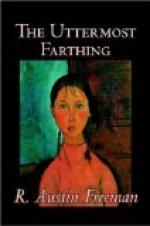I looked up at Challoner and found him regarding me with an inscrutable and hideous smile.
“These are very extraordinary productions, Challoner,” said I. “What are they? And what are they made of?”
“Made of, my dear fellow?” said he. “Why, the same as you and I are made of, to be sure.”
“Do you mean to say,” I exclaimed, “that these little heads are made of human skin?”
“Undoubtedly. Human skin and human hair. What else did you think?”
I looked at him with a puzzled frown and finally said that I did not understand what he meant.
“Have you never heard of the Mundurucu Indians?” he asked.
I shook my head. “What about them?” I asked.
“You will find an account of them in Bates’ “Naturalist on the Amazon,” and there is a reference to them in Gould and Pyle’s “Anomalies."”
There was a pause, during which I gazed, not without awe, at the open boxes. Finally I looked at Challoner and asked, “Well?”
“Well, these are examples of the Mundurucu work.”
I looked again at the boxes and I must confess that, as my eye traveled along the rows of impassive faces and noted the perfect though diminutive features, the tiny ears, the bristling hair, the frowning eyebrows—so discordant with the placid expression and peacefully closed eyes—a chill of horror crept over me. The whole thing was so unreal, so unnatural, so suggestive of some diabolical wizardry. I looked up sharply at my host.
“Where did you get these things, Challoner?” I asked.
His bloated face exhibited again that strange, inscrutable smile.
“You will find a full account of them in the archives of the museum. Every specimen is fully described there and the history of its acquirement and origin given in detail. They are interesting little objects, aren’t they?”
“Very,” I replied abstractedly; for I was speculating at the moment on the disagreement between the appearance of the heads and their implied origin. Finally I pointed out the discrepancy.
“But these heads were never prepared by those Indians you speak of.”
“Why not?”
“Because they are all Europeans; in fact, most of them look like Englishmen.”
“Well? And what about it?” Challoner seemed quietly amused at my perplexity, but at this moment my eye noted a further detail which—I cannot exactly say why—seemed to send a fresh shiver down my spine.
“Look here, Challoner,” I said. “Why is this head distinguished from the others? They are all in compartments lined with black velvet and have black labels with white numbers and dates; this one has a compartment lined with red velvet and a red label with a gold number and date, just as in the case of that end skeleton.” I glanced across at the case and then it came to me in a flash that the numbers and the dates were identical on both.
Challoner saw that I had observed this and replied: “It is perfectly simple, my dear fellow. That skeleton and this head were acquired on the same day, and with their acquirement my collection was complete. They were the final specimens and I have added nothing since I got them. But in the case of the head there was a further reason for a distinctive setting: it is the gem of the whole collection. Just look at the hair. Take my lens and examine it.”




